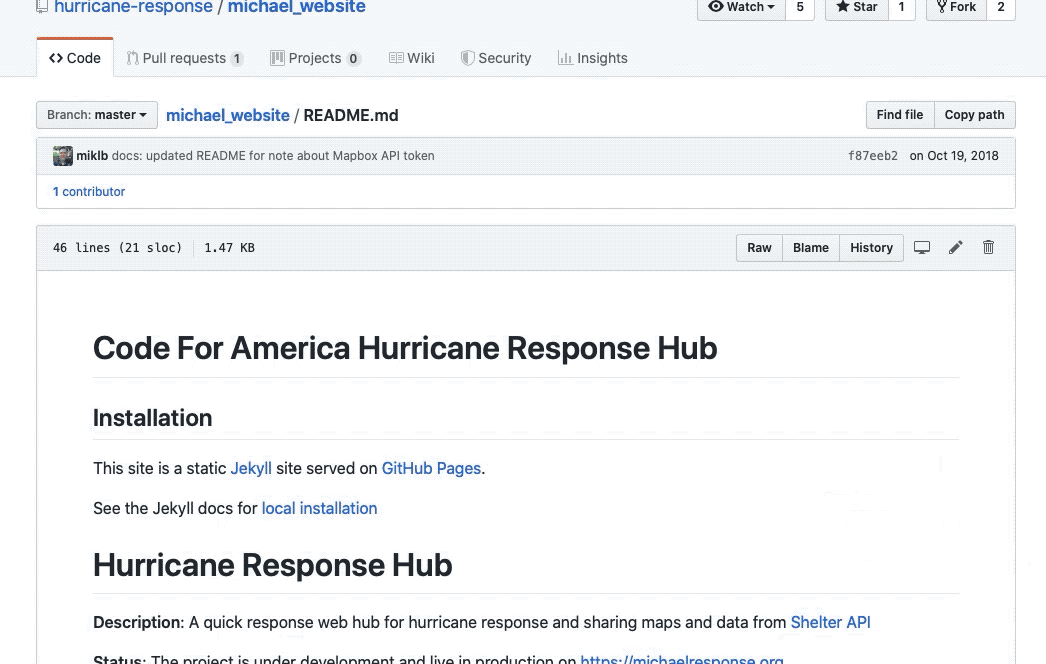🎊 🎉 You're Awesome!! 🎉 🎊
Thank you for considering a contribution to our project.
If you have never set up Jekyll or Ruby in your local environment, we recommend the Jekyll docs for installing on your platform.
We use the latest stable Ruby version for development
We also use Gulp for our build tool. Though Jekyll has support for Sass, we have opted to write plain CSS for 2019 browsers and let the tools backfill for compatibility. If you haven't worked with Gulp before, we recommend their getting started docs which includes a link to Node install steps
Clone the repository
git clone https://github.com/hurricane-response/response-theme.git
navigate to the directory
cd response-themeinstall the Jekyll dependencies
bundle installinstall the Gulp dependencies
npm iGulpfile has two main tasks: build and watch
build does just that - builds the _site directory.
watch watches both assets/css/_inc directory to check for CSS changes as well as Jekyll file changes and rebuilds the appopriate files.
A note about the CSS All CSS is in the _inc directory is plain CSS. Current browser support for variables is strong, but we use PostCSS to fill in browser compatibility. PostCSS also compiles assets/css/_inc/main.css into assets/css/main.css. You should never need to edit assets/css/main.css file directly.
Note The Jekyll Gulp task replaces the need to use bundle exec jekyll serve. Instead, use gulp watch.
Reminder that this is a Jekyll theme, not a stand alone site.
We optimized the build tools in this project with three goals:
- quick deploy.
- provide an out-of-the-box experience when using the theme as is.
- allow overriding
main.cssin the individual response site for event specific customizations.
When submitting a new Pull Request with CSS changes, make sure to edit a file in _inc and commit all file changes with your PR.
The issues. We ask that you create an issue before starting work on something, even if a new feature. We also ask that you adhere as best as possible to the issue template to help us better triage. Certainly small,minor typos do not require a novel, but the more information the better.
We have found that robust discussion before starting a new feature or large refactor has the greatest chance of success. Discussions can occur in the issue created or in Slack.
Note sometimes during an active response focus is on immediate needs and those of our partners. We respectfully ask that you use the issues and @ one of the contributors.
Yes! We understand that frustration. GitHub does a great job of providing an in-browser experience for editing files. If you don't have a GitHub account, first create an account, then we ask you to create an issue for your suggested fix. Then navigate to the file with the minor change. In the upper right corner, next to the trash can symbol is a pencil. That icon will allow you to start the editing process. GitHub automagically will create a fork with your change and walk you through submitting it as a pull request.
The message should be a short summary (max. 50 chars) written in the imperative, followed by an optional, more detailed explanatory text separated from the summary by an empty line.
Commit messages should follow best practices, including explaining the context of the problem and solution, including in caveats or follow up changes required. They should tell the story of the change and provide readers understanding of what led to it.
If you're lost about what this even means, please see How to Write a Git Commit Message for a start.
All Pull Requests should have an accompanying issue and will require review before merging.
**Note During an active response, this policy can be fluid, as events on the ground change and fixes are often needed ASAP. During those times, we ask you get an explicit OK or instruction from a maintainer before creating a PR not tied to an issue.
Only maintainers can merge PRs, and only they can decide whether to waive or defer a review on a PR. As a rule, this doesn't happen often, and only does during an active response or major service outage.**
We ask that you follow the template for Pull Requests in the same manner as issues.
We also ask that if your PR no longer merges cleanly, use rebase master rather than merge master.
Include an issue reference like Closes #XXXX or Fixes #XXXX in commits that close an issue. Including references automatically closes the issue on a merge.
All Pull Requests require peer review before merging to master. Pull Requests should also pass all tests before consideration of merging unless there is a clear reason.
Special thanks to the Moby project and their Contributing Guidelines for inspiration.
